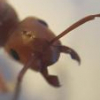1. Location (on a map) of collection: Northern Serbia
2. Date of collection: 6th of June
3. Habitat of collection: Earth, below clay tile
4. Length (from head to gaster): 8mm (plus minus 1mm)
5. Color, hue, pattern and texture: Black with white/silver hue
6. Distinguishing characteristics: /
7. Distinguishing behavior: Pulling quite a lot the cotton on test tube
8. Nest description: /
9. Nuptial flight time and date: /
Sorry for somewhat bad quality of photos. I'm not sure she is a queen, but it seems like she has wing scars, so I'm kinda keeping my hopes up. Even species ID would be useful as i would know what i have in my yard. Thanks in advance!





















